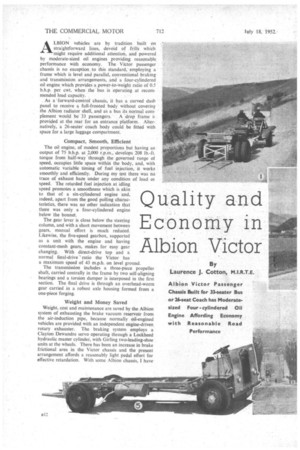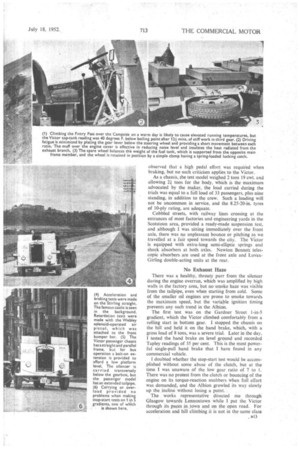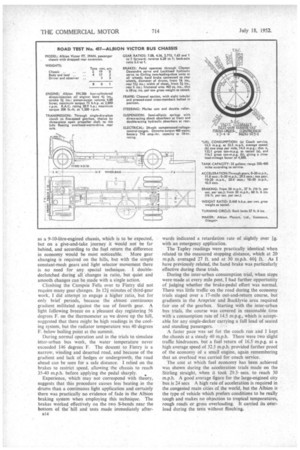Quality and Economy in Albion Victor
Page 46

Page 47

Page 48

If you've noticed an error in this article please click here to report it so we can fix it.
By Laurence J. Cotton, M.I.R.T.E.
Albion Victor Passenger Chassis Built for 33-seater Bus or 26-seat Coach has Moderatesized Four -cylindered Oil Engine Affording Economy with Reasonable Road Performance ALBION vehicles are by tradition built on straightforward lines, devoid of frills which • might require additional attention, and powered by moderate-sized oil engines providing reasonable. performance with economy. The Victor passenger chassis is no exception to this standard, employing a frame which is level and parallel, conventional braking and transmission arrangements, and a four-cylindered oil engine. which provides a power-to-weight ratio of 0.5 b.h.p. per cwt. when the bus is operating at recommended load capacity,
. As a ' forward-control chassis, it has a curved dash panel to receive a full-fronted body without covering the Albion radiator shell, and as a bus its normal com plement would be 33 passengers. A 'drop frame i$. provided at the rear for an entrance platform. Alternatively, a 26-seater coach body could be fitted with space for a large luggage compartment.
Compact, Smooth, Efficient
The oil engine, of modest proportions but having an output of 75 b.h.p. at 2,000 r.p.m., develops 208 lb.-ft. torque from half-way through the governed range of speed, occupies little space within the body, and, with automatic variable timing of fuel injection, it works smoothly and efficiently. During my test there was no trace of exhaust haze under any condition of load or speed. The retarded fuel injection at idling speed promotes a smoothness which is akin to that of a six-cylindered engine and, indeed, apart from the good pulling characteristics, there was no other indication that there was only a four-cylindered engine below the bonnet.
The gear lever is close below the steering column, and with a short movement between gears, manual effort is much reduced. Likewise, the five-speed gearbox, supported as a unit with the engine and having constant-mesh gears, makes for easy gear changing. With direct-drive top and a normal final-drive ' ratio the Victor has a maximum speed of 43 m.p.h. on level ground.
The transmission includes a three-piece propeller shaft, carried centrally in the frame by two self-aligning bearings and a torsion damper is interposed in the first section. The final drive is through an overhead-worm gear carried in a robust axle housing formed from a one-piece forging.
Weight and Money Saved Weight, cost and maintenance are saved by the Albion system of exhausting the brake vacuum reservoir from the air-induction pipe, because normally oil-engined vehicles are provided with an independent engine-driven rotary exhauster. The braking system employs a Clayton Dewandre servo operating through a Lockheed hydraulic master cylinder, with Girling two-leading-shoe units at the wheels. There has been an increase in brake frictional area in the Victor chassis and the present arrangement affords a reasonably light pedal effort for effective retardation. With some Albion chassis, I have
observed that a high pedal effort was requited when braking, but no such 'criticism applies to the Victor.
As a chassis, the test model weighed 2 tons 19 cwt. and allowing 24tons for the body, which is the maximum advocated by the maker, the load carried during the trials was equal to a full load of 33 passengers, plus nine standing, in addition to the crew. Such a loading will not be uncommon in service, and the 8.25-20-in. tyres of 10-ply rating, are adequate.
Cobbled streets, with railway lines crossing at the entrances of most factories and engineering yards in the Scotstoun area, provided a ready-made suspension test, and although I was sitting immediately over the front axle, there was no unpleasant bounce or pitching as we travelled at a fair speed towards the city. The Victor is equipped with extra-long semi-elliptic springs and shock absorbers at both axles. Newton Bennett telescopic absorbers are used at the front axle and LuvaxGirling double-acting units at the rear.
No Exhaust Haze
There was a healthy, throaty purr from the silencer during the engine overrun, which was amplified by high walls in the factory area, but no smoke haze was visible from the tailpipe, even when starting from cold. Some of the smaller oil engines are prone to smoke towards the maximum speed, but the variable ignition timing prevents any such trend in the Albion.
The first test was on the Gardner Street 1-in-5 gradient, which the Victor climbed comfortably from a rolling start in bottom gear. I stopped the chassis on the hill and held it on the hand brake, which, with a gross load of 8 tons, was a severe trial. Later in the day, I tested the hand brake on level ground and recorded Tapley readings of 35 per cent. This is the most powerful single-pull hand brake that I have found in any commercial vehicle.
I doubted whether the stop-start test would be accomplished without some abuse of the clutch, but at the time I was unaware of the low gear ratio of 7 to I. There was no protest from the clutch or bouncing of the engine on its torque-reaction snubbers when full effort was demanded, and the Albion growled its way slowly up the incline without losing a point.
The works representative directed me through Glasgow towards Lennoxtown while I put the Victor through its paces in town and on the open road. For acceleration and hill climbing it is not in the same class as a 9-10-litre-engined chassis, which is to be expected, but on a give-and-take journey it would not be far behind, and according to the fuel return the difference in economy would be most noticeable. More gear changing is required on the hills, but with the simple constant-mesh gears and light selector movement there is no need for any special technique. I doubledeclutched during all changes in ratio, but quiet and smooth changes can be made with a single action.
Climbing the Campsie Fells over to Fintry did not require many gear changes. In 124 minutes of third-gear work, I did attempt to engage a higher ratio, but for only brief periods, because the almost continuous gradient militated against the use of fourth gear. A light following breeze on a pleasant day registering 56 degrees F. on the thermometer as we drove up the hill, suggested that there might be high readings in the cooling system, but the radiator temperature was 40 degrees F. below boiling point at the summit.
During normal operation arid in the trials to simulate inter-urban bus work, the water temperature never exceeded 146 degrees F. The descent to Fintry is a narrow, winding and deserted road, and because of the gradient and Jack of hedges or undergrowth, the road ahead can be seen for a safe distance. I relied on the brakes to restrict speed, allowing the chassis to reach 35-40 m.p.h. before applying the pedal sharply.
Experience, which may not correspond with theory, suggests that this procedure causes less heating in the drums than a continuous light application and certainly there was practically no evidence of fade in the Albion braking system when employing this technique. The brakes worked effectively on the two S-bends near the bottom of the' hill and tests made immediately after 814 wards indicated a retardation rate of slightly over Ag. with an emergency application.
The Tapley readings were practically identical when related to the measured stopping distance, which at 20 m.p.h. averaged 27 ft. and at 30 m.p.h. 604 ft. As I have previously related, the hand brake was particularly effective during these trials.
During the inter-urban consumption trial, when stops were made at every mile post, I had further opportunity of judging whether the brake-pedal effort was normal. There was little traffic on the road during the economy trials staged over a 17-mile out-and-return course, but gradients in the Arnprior and Bucklyvie area required fair use of the gearbox. Starting with the inter-urban bus trials, the course was covered in reasonable time with a consumption rate of 14.5 m.p.g., which is acceptable for any single-decker carrying a full load of seated and standing passengers.
A faster pace was set for the coach run and I kept the chassis at a steady 40 m.p.h. There were two slight traffic hindrances. but a fuel return of 16.5 m.p.g. at a high average speed of 32.5 m.p.h. provided further proof of the economy of a small engine, again remembering that an overload was carried for coach service.
The cost at which fuel economy has been achieved was shown during the acceleration trials made on the Stirling straight, when it took 29.5secs. to reach 30 m.p.h. A good average figure for the large-engined city bus is 24 secs A high rate of acceleration is required in the congested main cities of the world, but the Albion is the type of vehicle which prefers conditions to be really tough and makes no objection to tropical temperatures, rough roads or gross overloading. It carried its overload during the tests without flinching. '
ROAD TEST No. 457—ALBION VICTOR BUS CHASSIS
MODEL: Albion Victor FT. 39AN. passenger chassis with dropped rear extension.
ENGINE: Albion EN,286 four-cylindered direct-injection oil engine; bore 41 ins., stroke 5* ins.; .piston-swept volume 4.88 litres; maximum output 75 b.h.p. at 2,000 r.p.m. R.A.C. rating 28,9 h.p.; maximum torque 208 lb.-ft. at 1,200 r.p.m.
TRANSMISSION; Through single-dry-plate clutch to five-speed gearbox, thence by three-piece open propeller shaft to the fully floating overhead-worm-drive rear axle. GEAR RATIOS: 7.08, 4.36, 2,715, 1.63 and 1 to 1 forward; reverse 6.28 to 1; back-axle ratio 5.2 to 1.
BRAKES: Pedal operates through Clayton Dewandre servo and Lockheed hydraulic servo to Girling two-leading-shoe units at all wheels; hand brake connected to rear wheels, diameter of drums, front 16 ins., rear 151 ins,: width of shoes, front 24ins., rear 5 ins.; frictional area 465 sq. ins., that is 58 sq. ins, per ton gross weight as tested.
FRAME: Channel section, with eight tubular and pressed-steel cross-members bolted in position.
STEERING: Merles cam and double roller, SUSPENSION: Semi-elliptic springs with direct-acting shock absorbers at front and double-acting hydraulic absorbers at rear.
ELECTRICAL: 24-volt compensated-voltagecontrol system. Dynamo output 480 watts; battery 116 amp-hr. capacity at 10-hr. rating,
7UEL CONSUMPTION: (a) Coach service, 16.5 m.p.g. at 32.5 m.p.h. average speed; Os) one stop per mile, 14.5 m.p.g.; that is, 132.1 gross ton-m.p.g, as tested (a), and 116,1 gross ton-m.p.g. (b), giving a timeload-mileage factor of 4,300.
TANK CAPACITY: 25 gallons; range 350-400 miles according to service.
ACCELERATION:Through gears, 0-20 m.p.h., 11.8 sect,; 0-30 m.p.h., 29.5 secs.; top gear, 10-20 m.p.h., 20.4 sets.; 10-30 m.p.h,, 42.5 secs.
BRAKING: From 20 rn.p.h„ 27 ft. (16 ft. per sect per sec.); from 30 m.p.h., 60 ft, '6 ins. (16 ft. per sec. per sec.).
WEIGHT RATIO: 0.460 b.h.p. per cwt, gros$ weight as tested.
TURNING CIRCLE: Both locks 57 Ic, Sins.
MAKER: Albion Motors, Ltd„ Scotstoun, Glasgow




























































































